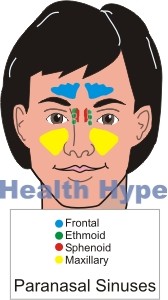Sinus Cavities (Paranasal Sinuses) Location, Anatomy, Pictures
The sinus cavities, proper term paranasal sinuses, are hollow air-filled cavities in the skull located around the nasal cavity. These rather unassuming pockets in the skull bone may have several important functions and are also prone to diseases that affect the nasal cavity. All the paranasal sinuses are connected to each other because it communicates with a common cavity – the nasal cavity.
Anatomy of the Paranasal Sinuses
There are four paranasal sinuses in humans, named according to the part of the skull where it is predominantly located. The paranasal sinuses do, however, extend to neighboring bones of the skull. From top to bottom, the four paranasal sinuses are the frontal, ethmoid, sphenoid and maxillary sinuses. It exists in pairs on both the right and left sides of the skull. The inside of the sinuses are lined with a thin mucous membrane which secretes small amounts of mucus. The rest of the sinus cavity is empty and filled with air.
Frontal Sinus
These are two large sinuses located on either side of the anterior part of the frontal bone (the front of the frontal bone) just above the orbits. The left and right frontal sinuses which usually differ in size have two parts – a horizontal and vertical part. Each frontal sinus has a duct known as the frontonasal duct which drains into the nasal cavity through the ethmoidal infundibulum.
Ethmoid Sinus
The ethmoid sinuses comprise three cells known as the anterior ethmoidal, middle ethmoidal and posterior ethmoidal cells. It lies in the ethmoid bone between the orbits (‘eyeball sockets’) and nasal cavity.
Sphenoid Sinus
The sphenoid sinuses are located in the bone at the base of the brain which is thin and fragile due to the presence of these sinus cavities. It lies in close proximity to several important structures in the cranial cavity which houses the brain, separated only by a thin bone. The sphenoidal sizes are unequal in size and may vary in position from the midline.It is essentially an extension of the posterior ethmoidal cells (ethmoid sinus).
Maxillary Sinus
The maxillary sinuses are the largest of the paranasal sinuses and located in the body of the maxilla (upper jaw). It is the sinus that is the most likely to become infected and given its size and close proximity to other key structures on the skull, there is a risk of the infection spreading. The maxillary sinus lie immediately below the floor of the orbit (‘eyeball socket’), to the side of the nasal cavity and above the roots of the maxillary teeth, particularly the first two molars.
Nerves of the Paranasal Sinus
- Frontal sinus – trigeminal nerve (supraorbital branches)
- Ethmoid sinus – trigeminal nerve (nasociliary branches)
- Sphenoid sinus – nasociliary nerve (posterior ethomoidal branches)
- Maxillary sinus – maxillary nerve (anterior, middle, posterior superior alveolar branches)
Location of the Sinus Cavities
- The frontal sinus is located in the frontal bone of the skull (cranium). It is positioned towards the midline in the lower part of the forehead and just above the orbit. Simply, it is located above the inner middle half of the eyebrows.
- The ethmoid sinus is located on the side of the nasal septum (bridge of the nose) between the eyes.
- The sphenoid sinus is located posterior to (behind) the nasal cavity just below the recess that houses the pituitary gland at the base of the brain.
- The maxillary sinus is located on the maxilla (upper jaw bones) in the cheek area (not the arches of the cheek bones).
Functions of the Paranasal Sinuses
The exact function of the sinus cavities are unclear. It is believed to contribute to the following :
- Assists with resonance of the voice
- Makes the skull lighter in weight
- Heats and humidifies (adds moisture) to the air before it reaches the airways and lungs
Various other functions of the paranasal sinuses have also been proposed. It is, however, a possibility that the paranasal sinuses have no function at all.







